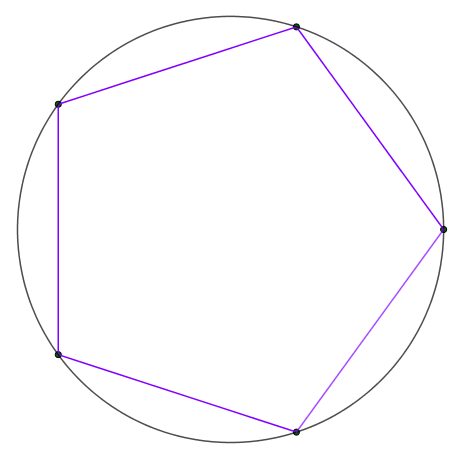Polygon Interior Sequence Derivation
Suppose we want to draw a regular n-gon inscribed into a circle. Let the circle center be at the axis origin. We will let the radius be $R$. The first point could go anywhere, but for convenience we will put it at $(R,0)$. We know that there will be $n$ distinct points around a circle. Since the circle is $2\pi$ rads around, the value for each of the $n$ angles must be $2\pi/n$. Therefore, to locate our 2nd point going counter-clockwise around, we would get $(R\cos\frac{2\pi}{n},R\sin\frac{2\pi}{n})^{note 1}$. Now our 3rd point must have twice the angle as the second, so it will be $P_{3}=R\left(\cos\frac{4\pi}{n},\sin\frac{4\pi}{n}\right)$. Each successive point will add a factor of $2$ in the numerator because we are adding the angle $2\pi/n$ each time.
note 1: If you don't understand how we get this unit vector calculation, read this section.
| Point Number | Location |
|---|---|
| 1 | $\left(R,0\right)$ |
| 2 | $R\left(\cos\frac{2\pi}{n},\sin\frac{2\pi}{n}\right)$ |
| 3 | $R\left(\cos2\cdot\frac{2\pi}{n},\sin2\cdot\frac{2\pi}{n}\right)$ |
| $\vdots$ | $\vdots$ |
| n | $R\left(\cos(n-1)\frac{2\pi}{n},\sin(n-1)\frac{2\pi}{n}\right)$ |
n-gon Starting at any point
We can derive the n-gon vertices starting anywhere on our circle. For example, let's have the first point be $(0,R)$, which is the top of the circle. The second point must have an angle between it and point $P_{1}$ which is $\frac{2\pi}{n}$ rads. But, the angle to the 1st point using conventional axes notation is now $\frac{\pi}{2}$ rads. Therefore the 2nd point must be at $$P_{2}=R\left[\cos\left(\frac{2\pi}{n}+\frac{\pi}{2}\right),\sin\left(\frac{2\pi}{n}+\frac{\pi}{2}\right)\right].$$ The third point must add another angle of $\frac{2\pi}{n}$,so $$P_{3}=R\left[\cos\left(2\cdot\frac{2\pi}{n}+\frac{\pi}{2}\right),\sin\left(2\cdot\frac{2\pi}{n}+\frac{\pi}{2}\right)\right] \tag{EQ3}$$ and the new sequence is $$P_{k}=R\left[\cos\left((k-1)\frac{2\pi}{n}+\frac{\pi}{2}\right),\sin\left((k-1)\frac{2\pi}{n}+\frac{\pi}{2}\right)\right],\quad k=1\dots n.$$ In this case the start angle is $\pi/2$. We can start at any position around the circle to achieve the n-gon points by just changing the value $\pi/2$ to the desired starting angle. In the figure we show a pentagon made by connecting the vertices from equation $\bbox[darkblue]{\eqref{EQ1}}$ .
